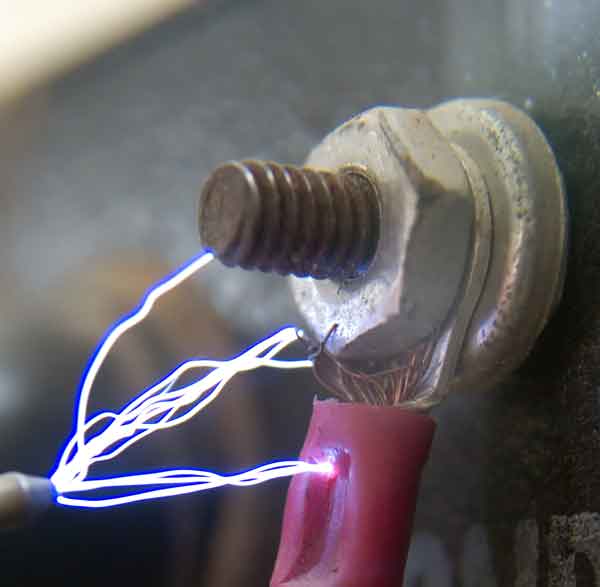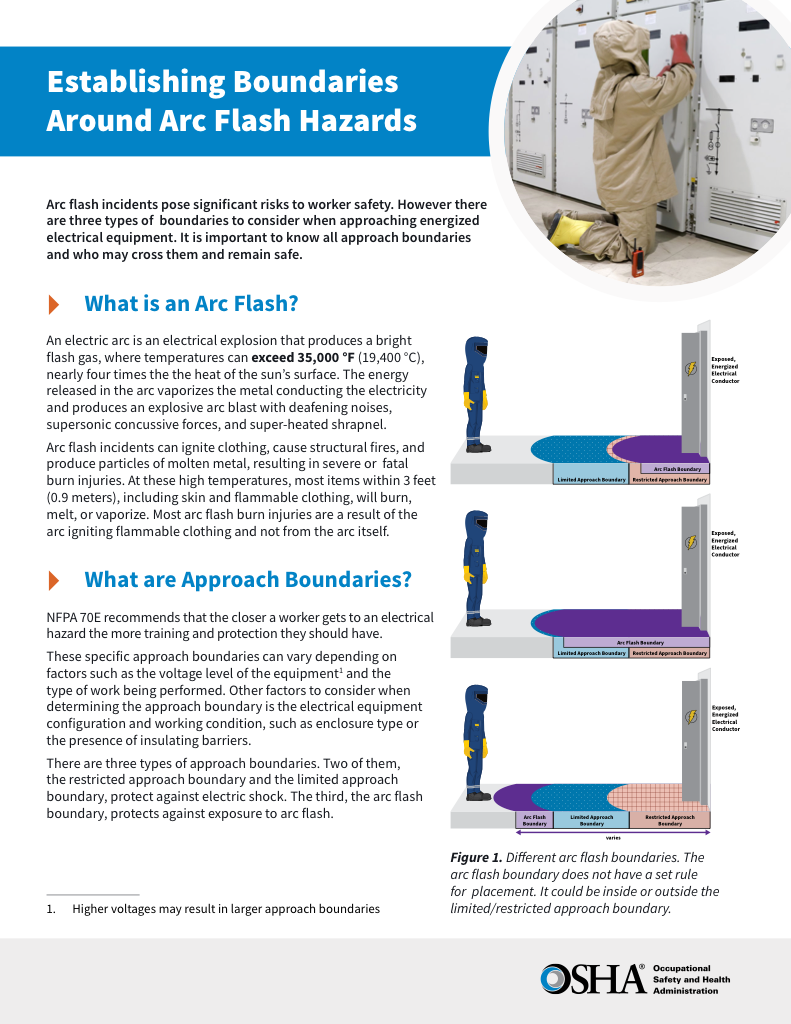How Much Resistance Does an Arc Conductor Have?

CSA Z462 Arc Flash Training - Electrical Safety Essentials
Our customized live online or in‑person group training can be delivered to your staff at your location.

- Live Online
- 6 hours Instructor-led
- Group Training Available
Download Our OSHA 4474 Fact Sheet – Establishing Boundaries Around Arc Flash Hazards

- Understand the difference between arc flash and electric shock boundaries
- Learn who may cross each boundary and under what conditions
- Apply voltage-based rules for safer approach distances
How much resistance does an arc conductor have? In plasma arcs, ionized gas exhibits non-linear I–V behavior; effective resistance depends on arc voltage, current density, temperature, electrode gap, and conductivity, yielding dynamic, time-varying impedance.
How Much Resistance Does an Arc Conductor Have?
An arc’s resistance is dynamic and non-linear, set by voltage, current, temperature, and gap.
✅ Effective resistance decreases as current and temperature rise.
✅ Governed by arc length, electrode material, and gas pressure.
✅ Modeled with dynamic plasma conductivity and sheath drops.
How Much Resistance Does an Arc Conductor Have?
The resistance of an arc conductor plays a crucial role in determining the behavior of electrical systems during a fault. Unlike standard conductors like copper or aluminum, an arc conductor is a high-energy electrical discharge that forms when electricity travels through the air or another medium due to insulation failure or faults. The arc’s resistance is unpredictable and varies based on factors like current, voltage, and the distance between electrodes. Accurately understanding the resistance of an arc conductor is essential for assessing the energy released, the severity of the fault, and the potential damage to electrical equipment, making it a critical factor in electrical safety and system reliability. For a concise primer on the phenomenon itself, see what electrical arcing is and how it differs from conduction in solid metals.
What is an Arc Conductor?
An arc conductor is essentially the medium through which electrical current flows during an arc fault. This is different from the standard conductors used in electrical systems, such as copper or aluminum, which have known and relatively low resistance values. In the case of an arc, the conductor can be air, gas, or any ionized material that has become conductive due to the extreme conditions of high voltage and temperature. These ionized paths behave differently from fixed-resistance materials, as explained in an overview of what causes electrical arcing under typical operating and fault conditions.
Test Your Knowledge About Arc Flash!
Think you know Arc Flash? Take our quick, interactive quiz and test your knowledge in minutes.
- Instantly see your results and score
- Identify strengths and areas for improvement
- Challenge yourself on real-world electrical topics
An arc fault typically occurs when an unintended path is created for electricity to flow through an insulating medium, such as air, leading to an electrical discharge. Arcs often develop in high-voltage systems, particularly when there are gaps in insulation, or when electrical connections become damaged or loose. Once an arc forms, the intense heat it generates can ionize the surrounding medium, further facilitating the flow of current. Understanding initiation mechanisms helps in prevention, and resources detailing what causes arc flash clarify how insulation breakdown and equipment condition drive risk.
Factors Affecting the Resistance of an Arc Conductor
The resistance of an arc conductor is not fixed like it is for a traditional conductor. Several factors can influence how much resistance is present in the arc, including:
-
Gap Distance: The physical gap between the electrodes or conductors plays a significant role in the resistance of an arc. A longer gap will generally have higher resistance because the current has to travel through a greater distance of air or another medium. However, the arc can sustain itself once it forms, and the resistance may decrease as the arc ionizes the air and becomes more stable. Practical limits on spacing are often discussed alongside the circumstances under which an arc flash occurs in switchgear and bus duct design.
-
Voltage Level: The higher the voltage, the more likely it is that an arc will form and sustain itself. High-voltage arcs tend to ionize the air more effectively, reducing resistance in the arc channel. This leads to higher current flow, which can cause more damage to equipment and increase the risk of injury. This relationship also explains many scenarios in how an arc flash occurs when elevated potentials overcome insulation strength.
-
Current: The amount of current flowing through the arc also affects its resistance. Arcs with higher current tend to be more stable and may have lower resistance, which allows more energy to flow through the arc. However, at lower currents, the resistance of the arc may be higher, making it more difficult for the arc to sustain itself.
-
Medium: The medium through which the arc forms plays a crucial role in determining its resistance. Air is a common medium, but arcs can also occur in gases like SF6 (sulfur hexafluoride), or in liquids like oil in high-voltage transformers. The properties of the medium will influence how easily it can become ionized and support an arc. For example, arcs in air may have higher resistance compared to arcs in a conductive gas like SF6.
-
Temperature: Arcs generate extremely high temperatures, often reaching thousands of degrees Celsius. As the temperature rises, the resistance of the arc conductor typically decreases because the intense heat ionizes the medium, creating a more conductive path for the current.
How Much Resistance Does an Arc Have?
The resistance of an arc conductor can vary widely depending on the factors listed above. In general, arcs are considered to have relatively low resistance once they are established, particularly in high-voltage systems. This low resistance allows for significant current flow, which in turn produces the intense heat, light, and energy characteristic of an electrical arc. The low impedance channel is a key reason discussed in treatments of how arc flash events happen in energized equipment.
While exact resistance values can be difficult to quantify due to the constantly changing nature of the arc, experimental data and simulations have provided some estimates. For instance, an arc in air with a gap distance of about 1 cm at 1,000 volts may exhibit resistance in the range of a few ohms to several tens of ohms. As the gap increases or the voltage changes, so too does the resistance.
Arc Resistance and Incident Energy
The resistance of an arc conductor is crucial in determining the amount of incident energy released during an arc fault. Incident energy refers to the thermal energy generated by the arc that can cause damage to equipment and serious injuries to workers. Lower resistance in the arc means more current can flow through, resulting in higher incident energy. This is why understanding arc resistance is essential for performing an arc flash hazard analysis and determining the appropriate personal protective equipment (PPE) for workers. This cause–effect pathway frames many explanations of why arc flashes happen and how energy scales with fault current.
In industrial environments, particularly those dealing with high-voltage electrical systems, managing the resistance of arc conductors is vital for electrical safety. Protective devices such as circuit breakers and relays are designed to detect arc faults and interrupt the current before the arc can cause significant damage. These devices must be calibrated based on the expected resistance of the arc to ensure they function correctly.
Electricity Today T&D Magazine Subscribe for FREE

- Timely insights from industry experts
- Practical solutions T&D engineers
- Free access to every issue
Can We Control the Resistance of an Arc?
While the resistance of an arc conductor cannot be directly controlled like a traditional resistor, steps can be taken to minimize the conditions that lead to arcs in the first place. This includes maintaining proper insulation, ensuring that electrical connections are secure, and using protective devices such as surge protectors and arc fault circuit interrupters (AFCIs). These measures help prevent the formation of arcs and reduce the risks associated with faulty electrical systems.
In some specialized applications, such as circuit breakers used in high-voltage systems, gases like SF6 are used to extinguish arcs quickly. These gases are more effective at quenching arcs because they reduce the arc's resistance by cooling the ionized particles, cutting off the current flow more rapidly.
The resistance of an arc conductor is a complex and dynamic factor that depends on many variables, including gap distance, voltage, current, and the medium in which the arc occurs. While arcs generally have low resistance once established, understanding their behavior is critical for managing the risks associated with electrical faults. By reducing the conditions that lead to arcs and employing proper safety measures, the dangers posed by arc faults can be minimized.








